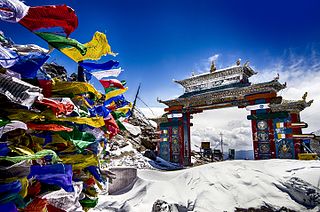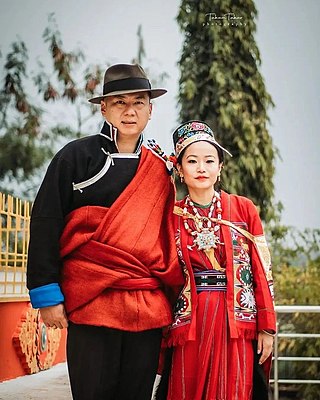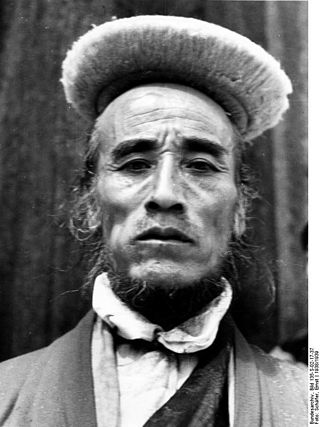Related Research Articles
Lhoba is any of a diverse amalgamation of Sino-Tibetan-speaking tribespeople living in and around Pemako, a region in southeastern Tibet including Mainling, Medog and Zayü counties of Nyingchi and Lhünzê County of Shannan, Tibet.

Arunachal Pradesh is a state in northeast India. It was formed from the North-East Frontier Agency (NEFA) region, and India declared it as a state on 20 February 1987. Itanagar is its capital and largest town. It borders the Indian states of Assam and Nagaland to the south. It shares international borders with Bhutan in the west, Myanmar in the east, and a disputed 1,129 km border with China's Tibet Autonomous Region in the north at the McMahon Line.

Northeast India (officially the North Eastern Region(NER)) is the easternmost region of India representing both a geographic and political administrative division of the country. It comprises eight states—Arunachal Pradesh, Assam, Manipur, Meghalaya, Mizoram, Nagaland and Tripura (commonly known as the "Seven Sisters"), and the "brother" state Sikkim.

The Monpa is a major tribe of Arunachal Pradesh in northeastern India. The Tawang Monpas have a migration history from Changrelung. The Monpa are believed to be the only nomadic tribe in Northeast India – they are totally dependent on animals like sheep, cow, yak, goats and horses. The Monpa have a very close affinity with the Sharchops of Bhutan.

The Sherdukpen are an ethnic group of Arunachal Pradesh state of India. Their population of 9,663 is centered in West Kameng district in the villages of Rupa, Jigaon, Thongri, Shergaon, to the south of Bomdila. All of these are at elevations between 5000 and 6000 feet above sea level. Of late, some of them have settled in Kameng bari areas, a new settlement area under Bhalukpong circle.
The Buguns are one of the earliest recognized schedule tribe of India, majority of them, inhabiting the Singchung Sub-Division of West Kameng District of Arunachal Pradesh. Buguns live in several exogamous clans. Traditionally, the predominant occupation was agriculture, supported with other allied activities like fishing and hunting, cattle rearing etc. Buguns have their own folklores, songs, dances, music and rituals. A rare bird, the Bugun liocichla, was named after the tribe.

Tawang district is the smallest of the 26 administrative districts of Arunachal Pradesh state in northeastern India. With a population of 49,977, it is the eighth least populous district in the country.

The Mishmi people are an ethnic group of Tibet and Arunachal Pradesh, India. The area is known as the Mishmi Hills. Only one group, called the Deng, occupy Zayu County in southern Tibet. The Mishmis began to identity with the legendary Vaishnava characters created during this period which led to the formation of an alternate identity.
The Chugpa is a small subtribe of Monpa community of the Arunachal Pradesh.
The Indian state of Arunachal Pradesh has a total population of roughly 1.4 million on an area of 84,000 km2, amounting to a population density of about 17 pop./km2. The "indigenous groups" account for about two thirds of population, while immigrants, mostly of Bengali/Hindi belt origin, account for a third person.

Bhotiya or Bhot is an Indian and Nepali exonym lumping together various ethnic groups speaking Tibetic languages, as well as some groups speaking other Tibeto-Burman languages living in the Transhimalayan region that divides India from Tibet. The word Bhotiya comes from the classical Tibetan name for Tibet, བོད, bod. The Bhotiya speak numerous languages including Ladakhi. The Indian recognition of such language is Bhoti / Bhotia having Tibetan scripts and it lies in the Parliament of India to become one of the official languages through Eighth Schedule of the Indian Constitution.
The Sharchops are the populations of mixed Tibetan, Southeast Asian and South Asian descent that mostly live in the eastern districts of Bhutan.

Tawang is a town and administrative headquarter of Tawang district in the Indian state of Arunachal Pradesh. It lies on NH-13 section of Trans-Arunachal Highway. The town was once the capital of the Tawang Tract, which is now divided into the Tawang district and the West Kameng district. Tawang continues as the headquarters of the former. Tawang is the number one tourist destination of Arunachal Pradesh.
Tshangla is a Sino-Tibetan language of the Bodish branch closely related to the Tibetic languages. Tshangla is primarily spoken in Eastern Bhutan and acts as a lingua franca in the region; it is also spoken in the adjoining Tawang tract in the Indian state of Arunachal Pradesh and the Pemako region of Tibet. Tshangla is the principal pre-Tibetan language of Bhutan.

The Khamba or Khemba, are a people who inhabit the Yang-Sang-Chu valley in the westernmost part of Arunachal Pradesh, near the borders with Tibet and Bhutan. Within the valley, they live in the villages Yorton, Lango, Tashigong, Nyukong and Mangkota.
Kharsang is a small town located in the Changlang district of Arunachal Pradesh, India. It serves as an administrative sub-division within the district. The town is primarily inhabited by the Tangsa tribe, which is a major ethnic group in the region.
The Kho-Bwa languages, also known as Kamengic, are a small family of languages spoken in Arunachal Pradesh, northeast India. The name Kho-Bwa was originally proposed by George van Driem (2001). It is based on the reconstructed words *kho ("water") and *bwa ("fire"). Blench (2011) suggests the name Kamengic, from the Kameng area of Arunachal Pradesh. Alternatively, Anderson (2014) refers to Kho-Bwa as Northeast Kamengic.
Christianity is the largest religion in the Northeastern Indian state of Arunachal Pradesh, which borders China. According to the census of 2011 Christians constitute 30.26% of the state's population. The Roman Catholic Church is the largest Christian denomination in the state with around 180,000 adherents. The Arunachal Baptist Church Council is the second largest denomination with 150,000 baptized members in about 1,200 churches and Arunachal Pradesh Christian Revival Church Council (APCRCC) which started in 1987 at Naharlagun also growing fast.

Mechukha or Menchukha is a town, assembly constituency and subdivision, situated 6,000 feet (1,829 m) above sea level in the Mechukha Valley of Yargep Chu/ Siyom River in Shi Yomi district of Arunachal Pradesh state of India. Before the 1950s, Mechuka valley was known as Pachakshiri.

Nyishi (Kamle) or Sarak is a Tani language of India. It is spoken in Arunachal Pradesh by an estimated 9,000 people of the Nyishi tribe. It appears to be a dialect of the Nishi language.
References
- ↑ Mahendra Lal Patel (1997). Awareness in Weaker Section: Perspective Development and Prospects. M.D. Publications Pvt. Ltd. p. 253. ISBN 81-7533-029-5.
- ↑ Christopher Moseley (2007). Encyclopedia of the World's Endangered Languages. Routledge. p. 297. ISBN 978-0-7007-1197-0.
- Tshangla language
- Gender Analysis : Case Study of Arunachal Pradesh, from , previously on https://web.archive.org/web/20040803135211/http://www.mssrf.org/fris9809/index.html, Text based on the Case Study of Ms. Sumi Krishna. Gender Dimensions in Biodiversity Management : India. Report submitted to FAO Regional Office for Asia and the Pacific, Bangkok, Thailand. June 1997.